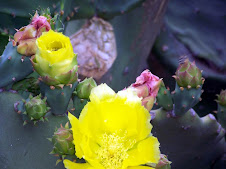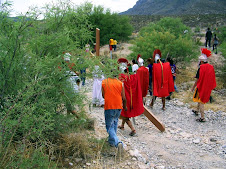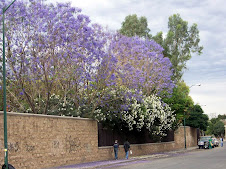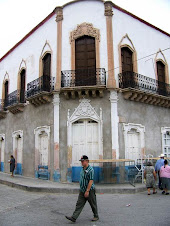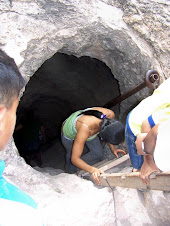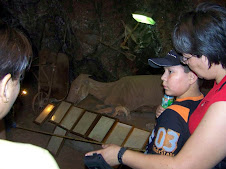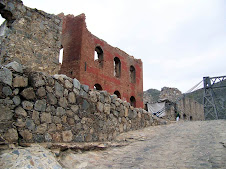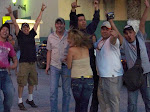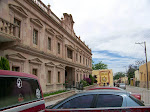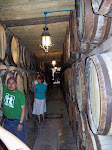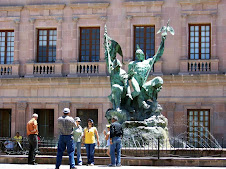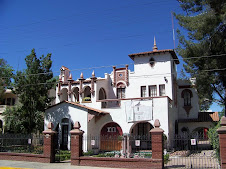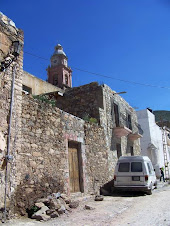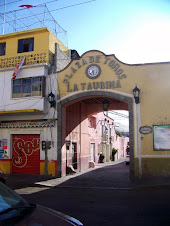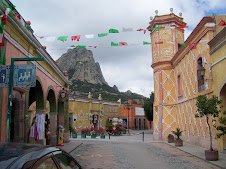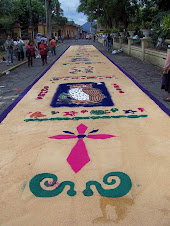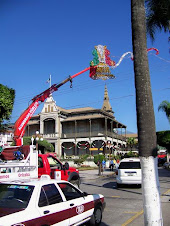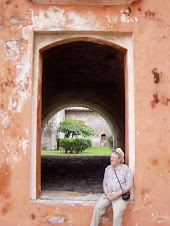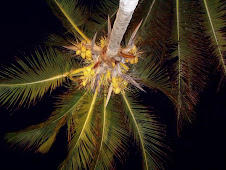My friend John Gaston had warned me weeks in advance of our departure of problems looming on the horizon -- not only the drug war, but the crisis at Mexicana Airlines and the hurricanes making landfall east of Chiapas, affecting the massive rivers of that state as well as those of south Veracruz and northern Oaxaca. Thinking that his concerns would be behind us by the time we left, I continued to rely on my airline reservations with Mexicana until the news broke on CNN that they were shutting down, causing me to scramble to find other tickets on AeroMexico. When the latter changed the itinerary of the San Antonio-Mexico City leg of the trip, we lost our connection on the Mexico City-Tuxtla Gutierrez leg, which is when I decided to rent a car from Thrifty. Big mistake. I should have opted for staying in the City for one night and continuing on by plane the following day. From the guide books, I learned that we could have relied entirely on ground transportation for the entire trip, making rental of a car unnecessary -- and as it turned out, an exorbitantly expensive option. Something tells me I am getting too old to ignore friends' advice.
Things started getting out of hand pretty early, two weeks before departure with the announcement that our Mexicana reservations had been canceled, causing me to spend hours online trying to get alternate flights both into Mexico and to Tuxtla. I secured AeroMexico reservations but lost the connection when AeroMexico changed the San Antonio departure time from morning to afternoon. Due to the late arrival in the Federal District ("Dee Effey"), we did not get on the road in the rented VW Jetta until well into the rush hour, which can be hectic in any city and a nightmare in Mexico City. We took the Veracruz toll road, which joins up with the Oaxaca autopista and, eventually, the toll road to Villahermosa, gateway to the Yucatan Peninsula. Our plan had been to take this latter cuota as far as Minatitlan, where a two lane toll road goes more or less directly down to Tuxtla Gutierrez. It didn't quite work out that way. As my older brother is constantly reminding me, "When in Mexico, expect the unexpected." Looking back on it all, I should have known we might have trouble taking coastal routes following in the heels of a hurricane that crossed three states, including eastern Chiapas, after chewing up and spitting out the petroleum-rich, river delta state of Tabasco.
We had spent the night in Orizaba, at the foot of Mexico's tallest mountain, a perfect peak more or less in the shape of the classic Mexican cavalry hat. Well, close to it, anyway. Orizaba has one of Mexico's largest breweries and the people like to have fun. Still, it pretty much shuts down early on Saturdays. We glanced inside the guide book recommended La Troje restaurant just around the corner from our hotel and it was empty of all save spiffy waiters in starched white uniforms. Too expensive for us. So we ate tacos in a joint across from the plaza. Alex and Zack are gluttons when you put tacos al pastor in front of them; in fact, from our less than memorable trip to Acapulco last year they came away with fond memories of late night tacos in a sear and slice joint catercorner to our hotel with no running water. (They could not afford water because it was off season, one supposes.) In addition to its brewery, Orizaba is famous for its Eiffel building, a fascinating structure made entirely of steel, taken apart piece by piece, shipped to Mexico, and reassembled off the zocalo here under M. Eiffel's personal guidance.
The Gran Hotel de France, on the main drag, is a discovery of my brother, Terry, and me when we visited a couple of years ago. All the hotels in the area have more or less the same rates (we paid $65 for two rooms, as they only had two "matrimonials" in each room and my sons are not comfortable sharing a bed (matrimonios are a kind of "double" bed.) Unlike some of the other hotels, the Gran has a lot of character. It is built around a central courtyard where meals are served to guests and the public. It has free parking in back, entered through the same side street the La Troje is on. We got a pretty good night's sleep and in the morning had breakfast on the way out of town. We look forward to our Mexican breakfasts, usually huevos al gusto or chilaquiles de casa, though the breakfasts we really dreamed of were those of Ajijic and Escondido.
Plan? We Don't Got to Show You No Stinkin' Plan!
Our plan was to get back on the D.F.-Veracruz toll road, take the cut-off to toll road 145D (heading for Villahermosa, the gateway to the Yucatan). We would find the "new" toll road down to Tuxtla Gutierrez via Presa Nezahualcoyotl, a large, inland, man-made lake north of the Sumidero Canyon, Chipa de Corzo, and Tuxtla itself. There was just one problem: a hurricane had gone into the Isthmus and all points south via the State of Tabasco. The toll road going to Acayucan and Minatitlan were under water and we were detoured on some third rate road after going many miles out of the way on the "libre." At some point, we learned that there was no passage on that road, too. The third rate road, starting at a town called Isla, looked on the map to be a handy shortcut, but within minutes had us bumping up and down for an hour on roads better suited to burros. We got lost many times and got curious stares from the shop owners and the federales when we asked for directions.
And that was the least of our problems. Finding ourselves at long last on Mexican Highway 147 from Tuxtepec to Juchitan, but on the mountain roads with no shoulders as luck would have it, we wound up in hours-long roadjams where one lane had to be closed while work proceeded on the other, leading to long waits, inchworm advances forward, and dwindling hopes of making even Tuxtla by dark. Yes, this is before dark. We kept looking at the all terrain vehicle owner in the trailer ahead of us: he kept checking the cinch rubber around his cargo, almost like an obsessive-compulsive. (Alex swears that we saw him on the beach, later, in Escondido. But I am getting ahead of myself.) It was almost midnight when we finally pulled into the nearest town that purportedly had a hotel or two: Matias Romero. We did find a room, had a too-late dinner, and retired.
We finally arrived in Tuxtla at 3 p.m. the following day. I was running low on pesos and tried to get $100 bills exchanged at Bancomer, the Mexican equivalent of BBVA Compass in the States. I had been misinformed that changing dollars into pesos was easy if you had a BBVA account. While this is no doubt true, is it also misleading: If you only have a BBVA Compass account, your debit-credit card may or may not help you, probably depending on the city. I only learned in Mexico City ten days later that Compass and Bancomer operate independently and the latter puts limits on how much you can exchange in given month. We had only intended to drive down Belesario Dominguez, the main drag, for a quick pop into the bank. It ended up taking an hour.
The drive over to Chiapa de Corzo is fairly spectacular once you get out of the burbs, which are terribly congested and ugly, reminding me vaguely of the outskirts of Acapulco. Sometimes when one is being touristy in a city's zona centro, one forgets that there are slums in the hills where even the service industry refuses to live. Chiapa de Corzo is just the other side of a magnificent bridge going over the Rio Grijalva at the beginning of the Cañon Sumidero and is dominated by the Pila, an architectural centerpiece in the big plaza, done in the 16th century, Moor-inspired Mudejar style. We stayed at the mediocre Hotel Los Angeles, which "didn't have" any of the fan-only rooms, only the ones with a/c, kicking the price up considerably -- much to my chagrin when it dawned on me that we practically had rooms to ourselves. As they only had the double bed they call a matrimonio. Although we only stayed the night ($60), I would have moved to another hotel for a longer stay. We took our evening meal at the Corredore at the other end of the plaza ($6 milanesa, $5 fried chicken plate).
Breakfast was had at the corner of the portales nearest the Los Angeles. We wanted to get off early as possible for a launch trip up the Grijalva into the canyon. The excursion costs $12 each, including use of a life jacket, without which you cannot go along. Later, I would rue not taking a my long-sleeved windbreaker or not applying sunscreen, as the mid-morning sun burned my arms (something I can ill afford, being prone to skin cancer). Unfortunately, effluvia from the hurricane, the same hurricane that ruined our driving plans, had washed into the river a ton of plastic water bottles and other garbage. Not a turn of the boat took us into water not dotted by the trash accumulation. We noticed a clean-up crew in a boat near the painted rock outcropping of a cave that is home to a retablo in living color. Alligators taking sunbaths lined the rock ledges at water level; one is unable to tell is they are asleep or playing dead, they do not move.
Enchanting San Cristobal
We arrived in San Cristobal early enough to shop for a small fan, which seemed absurd in the near perfect weather of these mountains in early October: crisp and clear of everything but the heady smoke from charcoal burners mixed with the mesmerizing smell (at least in the nearby Tzotzil and Tzeltal villages) of copal incense. Simply explained: my son Zack has tinnitus, a ringing in the ears, which does not bother him at night if he has the drone of an electric motor. So much for being in a garage ban for years. Since I was last in S.C. de L.C. my old hotel, the Jardines de Cerillo, a couple of blocks from the artesanias market, has remodeled. The restuarant has disappeared, its entrance now the main door to the hotel itself. We got a nice room in one of the off season "promotions," three beds and a fireplace for $56. Not at all bad for this tourist mecca.
The city itself is magic and cast a glamour over my sons. They found the cathedral plazas, where so many young people gather to enjoy the local ambience, delightful, and the shopping for artesanias without equal even in Oaxaca (though one doubts they could rival those of Patzcuaro). There is something about San Cristobal that you can't put your finger on; it is just out of reach, and it even embraces the city's silly ways, such as presenting diners with an extensive menu, then informing them that the only thing they had was tortas -- a scene out of Buñuel. This actually happened to us the night we arrived, at the misleadingly-named Emiliano's Moustache. Ordinarily, I would not be caught dead in such a place, but the guide book had given it thumbs up. We were so disappointed, we went elsewhere.
We discovered a treasure: a small, attractive restaurant called the Maya Pakal in the middle of the jumble of eating spots and gift shops to the east of the main plaza. The menu here is varied and the entrees reasonably priced. We wound up eating breakfast here twice, including the following morning, when we went out to San Juan Chamula, the quintessential tzotzil village. After parking, we were immediately accosted by an obnoxious woman with a baby in tow who had a novel approach to selling her somewhat shoddy textiles: She asks your name, then approaches you repeatedly and for hours, using your name as if you were an old friend. The boys were amazed at the cathedral, with its shamanistic practices (rituals on a floor covered with pine needles) and its unique altarpiece, John the Baptist occupying the center of the paintings, the primary object of worship. I thought, Aha, Johanites, and in Mexico no less!
As it happened, we had arrived at a propitious moment: the city fathers had gathered in the band stand in a large arena between the cathedral and the market, observing a festival dance. Dancers with masks ("viejo" and other motifs) stomped about to the accompaniment of a village band. Some of the roles were played by small boys, and dancers with roll-about bull's heads of papier mache set off fireworks from time to time. Alex tried to take a video and was told it was forbidden. Once the dance ended, the dancers exited the arena in a long line, and we went into the amazing Templo de San Juan. We also went over to Zinacantan, another village known for its artesanias, though we found the place somewhat inhospitable and lacking in commercial expertise. The shops looked closed.
The city itself is magic and cast a glamour over my sons. They found the cathedral plazas, where so many young people gather to enjoy the local ambience, delightful, and the shopping for artesanias without equal even in Oaxaca (though one doubts they could rival those of Patzcuaro). There is something about San Cristobal that you can't put your finger on; it is just out of reach, and it even embraces the city's silly ways, such as presenting diners with an extensive menu, then informing them that the only thing they had was tortas -- a scene out of Buñuel. This actually happened to us the night we arrived, at the misleadingly-named Emiliano's Moustache. Ordinarily, I would not be caught dead in such a place, but the guide book had given it thumbs up. We were so disappointed, we went elsewhere.
We discovered a treasure: a small, attractive restaurant called the Maya Pakal in the middle of the jumble of eating spots and gift shops to the east of the main plaza. The menu here is varied and the entrees reasonably priced. We wound up eating breakfast here twice, including the following morning, when we went out to San Juan Chamula, the quintessential tzotzil village. After parking, we were immediately accosted by an obnoxious woman with a baby in tow who had a novel approach to selling her somewhat shoddy textiles: She asks your name, then approaches you repeatedly and for hours, using your name as if you were an old friend. The boys were amazed at the cathedral, with its shamanistic practices (rituals on a floor covered with pine needles) and its unique altarpiece, John the Baptist occupying the center of the paintings, the primary object of worship. I thought, Aha, Johanites, and in Mexico no less!
As it happened, we had arrived at a propitious moment: the city fathers had gathered in the band stand in a large arena between the cathedral and the market, observing a festival dance. Dancers with masks ("viejo" and other motifs) stomped about to the accompaniment of a village band. Some of the roles were played by small boys, and dancers with roll-about bull's heads of papier mache set off fireworks from time to time. Alex tried to take a video and was told it was forbidden. Once the dance ended, the dancers exited the arena in a long line, and we went into the amazing Templo de San Juan. We also went over to Zinacantan, another village known for its artesanias, though we found the place somewhat inhospitable and lacking in commercial expertise. The shops looked closed.



